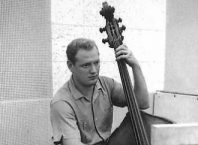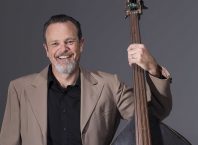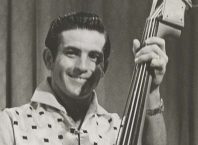In the period of 1970’s, most of the bands that were playing 1950’s rock’n’roll and rockabilly were using bass guitar. Ray Campi was one of rare players that kept the tradition of slap bass alive. Those who attended some of his shows remembers his charismatic performance and influential stage persona. Ray’s appearance at the “Blue Suede Shoes”, a three day rock’n’roll festival that happened in England in 1979, was the introduction of slap bass to many young Teddy Boys and rockers. This legendary concert was later released as a feature film that remained as the evidence of Ray’s performance on this wild weekend.
Originally from New York (born in Yonkers, NY in 1934), Ray Campi was always drawn to southern culture and music. He moved to Austin, Texas when he was ten and soon started learning to play standard and steel guitar. He made many recordings in the 1950’s, but it wasn’t untill 1970’s when his career took off when he switched to upright bass and was rediscovered by Ronny Weiser. He released thirteen of Ray’s albums and dozen of singles for his record label Rollin’ Rock. Ray Campi’s music is now available on more than 55 vinyl records and CDs worldwide.
I’m proud to present to you here, on the Art of Slap Bass, member of the Rockabilly Hall of Fame, the musician known as the King of Rockabilly:
RAY CAMPI

Djordje: Hi Ray,
On your early records, like with Ramblin’ Ray and the Ramblers, you were mostly playing guitar and singing. Now you’re considered as one of the rockabilly bass legends. When did you make the switch and what inspired you to play double bass?
Ray: Ronny Weiser of Rollin’ Rock Records insisted that I have a double bass on my records.
Djordje: How did you learn to play bass?
Ray: Ron bought the first bass and I listened to old records to learn how to play and slap the strings.
Djordje: How many instruments did you own, what are they and what do you currently use?
Ray: I have 3. In England I have my first Kay bass (spruce) and I have one in Texas and one in LA, brands unknown (both plywood).
Djordje: For a long time you had a confederate flag at the back of your white bass. There are also photos available of the similar bass with a Texas flag in the back. Why did you change it?
Ray: My publicity began listing me as being from Texas so I thought that Texas flag fit me more accurately as I was raised in Austin.
Djordje: What kind of strings were you using when you started playing bass and what kind are you using now?
Ray: Ones that were not broken. I use the “Rockabilly” brand of strings and “D’Addario”.
Djordje: What came first, pizzicato or slap and how did you learn the slap technique?
Ray: First the string is pulled to get the note, then the side of the forefinger bumps the fingerboard. I experimented.
Djordje: Who were your bass influences when you started?
Ray: As a kid I saw many hillbilly bands using slap bass, live and in old movies. The comics in these bands usually did tricks with the bass.

Djordje: Who were your contemporary slap bassists that you liked?
Ray: Pee Wee Faury who played on my 1951 session and with Gene Snowden – The Treniers, Fred Maddox, Bill Black, Marshall Lytle, Marshall Grant.
Djordje: Do you like any slap players nowadays?
Ray: Yes, Russell Scott, Paul Diffin, Gator, Lee Rocker and many more.
Djordje: You always have amazing stage presence. Climbing on the bass, riding it, lifting it up in the air and other bass tricks are big part of your show. When did you develop that style?
Ray: I saw many old movies with black bass players doing tricks, The Treniers and Marshall from the 1950’s RocknRoll films. I developed the “fall” off of the bass myself in the 1970’s. It looks difficult but it is safe and easy to do.
Listen to St. Louis Blues by Louis Armstrong (1920’s).
Djordje: You were one of rare bassists that used slap bass technique in the 1970’s when you were touring with your band Ray Campi and his Rockabilly Rebels. You were a huge influence specially on younger rockabilly bassists in England. What do you think is the reason that slap bass was so rarely used, even in rockabilly music, in the period of 1960’s and 1970’s?
Ray: When I first met Johnny Cash in Austin in 1957, the double bass was being secured to the roof of a ’56 Lincoln. Most bands traveled in one or two cars and there was almost no room for the double bass. The Fender solved the problem. Fender and guitar style basses were easy to play, store and emitted consistent notes, and volume.
Djordje: During your long career you recorded many albums and performed with many rock’n’roll pioneers. Could you name some of those?
RAY: I recorded with Merle Travis, Tony Conn, and Jack Waukeen Cochran. I also performed with Johnny Carroll, Bo Diddley, The Comets, Lefty Frizzell, Merle Travis, Joe Maphis, Collins Kids, Glen Glenn, Eddie Dean, Rose Maddox, Rosie Flores, Rip Masters, Jimmie Heap band. I was on the bill with these folks.
Djordje: You were doing a lot of different things in music business, but you never did it full time. What is the reason for that and do you see yourself mostly as a bassist, guitarist, singer, songwriter or something else?
Ray: I’m a good songwriter, a very versatile singer and a half-ass player on the other things. The 1960’s hippie drug bands put me out of the business.
Djordje: You were a junior high school teacher in Los Angeles for over 25 years. You were teaching many different subjects including English, drama, physical education, media techniques, US and world history. Were your students aware of rock’n’roll part of your career?
Ray: Many were and became fans and helped me over the years as Bill Malin, Stuart Shostack, David Zalkus and others.
Djordje: Who are you playing with these days?
Ray: I have the new Rockabilly Rebels: Rip Masters piano, Kevin Fennell lead guitar, Pep Torres rhythm guitar, D.J. Bonebrake drums.

Djordje: How do you like to record your bass?
Ray: I use a like mic placed about 3 feet from the center of the bass. Sometime I use 2 mics.
Djordje: What songs that you recorded would you recommend to bass players that are interested in your slap technique?
Ray: Rattlin’ Daddy, My Baby Left Me, Wrong Wrong Wrong, Rockin’ At The Ritz. All recorded for Rollin’ Rock. I also suggest “No Help Wanted” by the Carlyles (1955) and any old 1920’s black blues and jazz records.
Djordje: Are there any plans for touring or recording new albums?
Ray: Rip Masters has recently produced a new album of 25 made famous and written by Jimmie Skinner.I’ll be at England’s Americana Festival 2010.
Djordje: What are your preferences for amps and pickups?
Ray: I recently began to use a small “Workman” amp which suites my needs. I use Underwood pickups.
Djordje: Do you use any other equipment when playing live?
Ray: I never use a mike for the slap attached to the fingerboard. I like the natural sound of the slap, no other effects.
Djordje: Slap bass is very intense way of playing. Do you do any wrist stretches or other type of warm ups before the show?
Ray: No, I just wake up in the morning and thank God.
Djordje: What do you suggest to younger players to practice on a daily basis?
Ray: I never practice. No, don’t know. It depends on how advanced their playing skills are. Most new players have the most trouble finding the correct intonation on the fingerboard.
Djordje: Thank you for finding time to do this interview and hope to see you play sometime soon!
Ray: Thank you Djordje for your interest!




